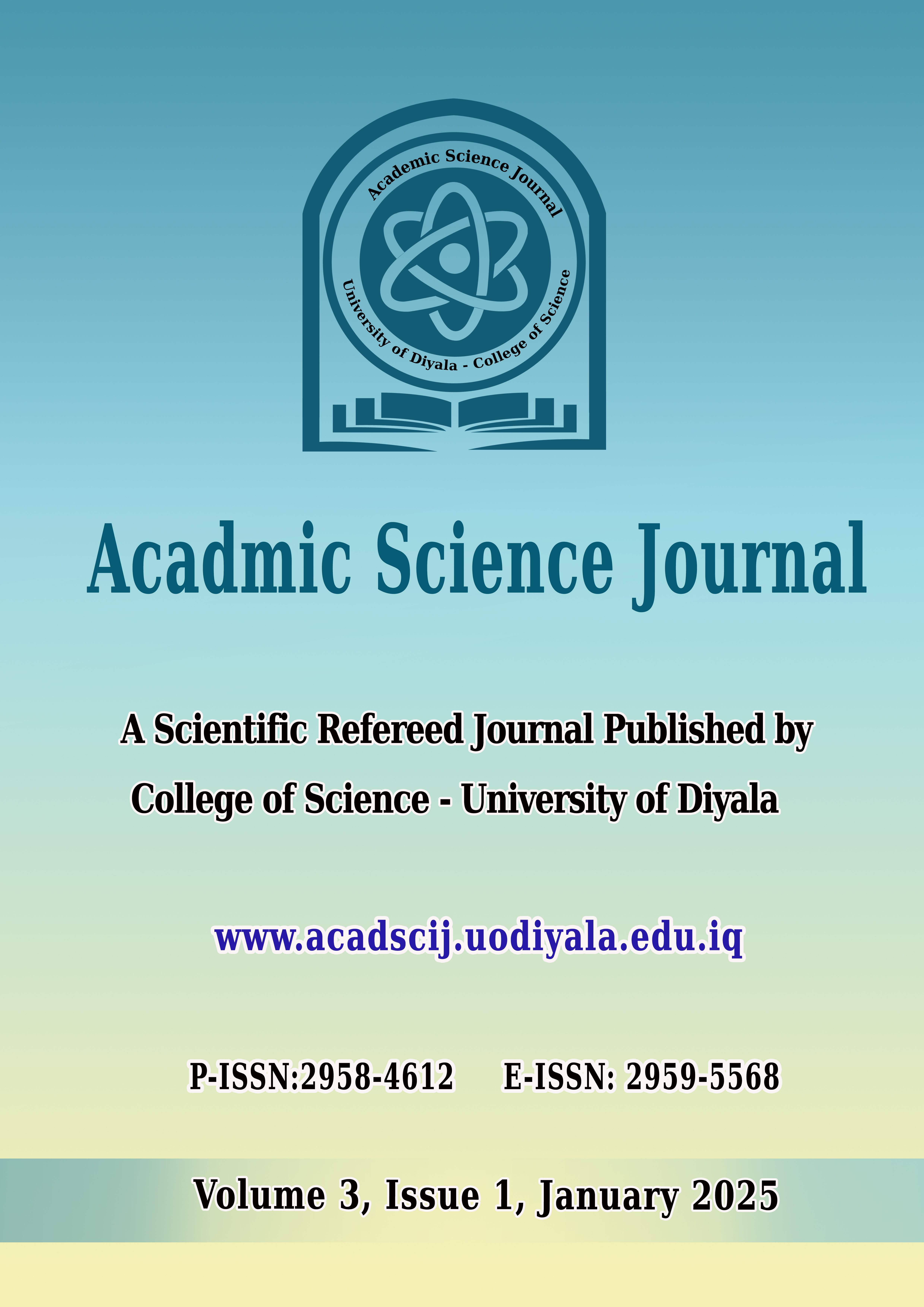Molecular Detection of Candida tropicalis Isolated from Immunocompromised Patients with Otitis Media
Molecular Detection of Candida tropicalis Isolated from Immunocompromised Patients with Otitis Media
DOI:
https://doi.org/10.24237/ASJ.03.01.816BKeywords:
Candida tropicalis, Als2 gene, Otomycosis, Immunocompromised patientsAbstract
Otomycoses are fungal infections that affect the external ear canal and, in some cases with perforated tympanic membranes, the middle ear. Candida are most common fungal genera causative agents of otomycoses. Candida tropicalis is a species of yeast in the genus Candida. One hundred swaps were collected from patients with otitis media who attended ENT consulting clinic at Baquba Teaching Hospital for a period extended from 15th of December 2022 to the 15th of March 2023. The specimens were collected from immunocompromised and immunocompetent patients (50 each of). Clinical diagnosis was done by consultant Otolaryngologist. Cultural methods including (Sabouraud's dextrose agar medium (SDA) and Hi-Chrom Candida agar) media with incubating at 37°C for 48 h, and Molecular methods (Conventional PCR and gene sequencing) for ITS and Als2 genes were used for identification of C. tropicalis . The susceptibility of isolated C. tropicalis was tested toward fluconazole (10 mg) and miconazole (10 mg) antifungals by using disk diffusion method. The results were males have the highest rate among immunocompromised patients with otitis media (58.0%). According to the rate of C. tropicalis identification, 14.0% (7 out of 50) isolates were collected from otitis media immunocompromised patients. Antibiotic susceptibility results revealed that only 3 isolates of C. tropiclais (25.0%) were resistant against both antibiotics (Fluconazole and Miconazole). PCR results showed that the molecular weight of ITS and als2 genes are was 520 bp and 80 bp., respectively. The mutant isolate, has more than one substitution mutations. We are concluded that Candida tropicalis is reported as the most causative agent of otitis media. Als2 gene may be play an important role in the virulence of C. tropicalis among immunocompromised patients with otitis media.
Downloads
References
L. Monasta, L. Ronfani, F. Marchetti, M. Montico, L. Vecchi Brumatti, A. Bavcar, D.
Grasso, C. Barbiero, G. Tamburlini, Burden of Disease Caused by Otitis Media:
Systematic Review and Global Estimates, PloS one, 7(4), (2012),
DOI(https://doi.org/10.1371/journal.pone.0036226)
A. Howlader, P. Nagarajan, L. Ragunathan, Mycological Profile in Otomycosis
Patients and their Drug Sensitivity: A Cross-sectional Study at Union Territory of
Puducherry, India, Journal of Clinical & Diagnostic Research, 16(10), 11-15(2022),
DOI(https://doi.org/10.7860/JCDR/2022/57715.17073)
P. Debta1, S. Kumar Swain, S. Lenka, C. Sahu, Otomycosis: A Comprehensive
Review, Indian Journal of Forensic Medicine & Toxicology, 14(4), 8429-32(2020)
P. Mastromarino, B. Vitali, L. Mosca, Bacterial vaginosis: a review on clinical trials
with probiotics, New Microbiologica, 36(3), 229-238(2013)
B. Viswanatha, D. Sumatha, M. Siddappa Vijayashree, Otomycosis in
Immunocompetent and Immunocompromised Patients: Comparative Study and
Literature Review, Ear, Nose & Throat Journal, 91, 114-121(2012),
DOI(https://doi.org/10.1177/014556131209100308)
M. T. Shiara Marriz, R. D. Lylah, Comparison of the effect of miconazole and
clotrimazole in the treatment of vulvovaginal candidiasis among women seen in a
tertiary medical center from 2016 to 2020,Philippine Journal of Obstetrics and
Gynecology, 46(3), 109-117(2022), DOI(10.4103/pjog.pjog_24_22)
J. Chalupová, M. Raus, M. Sedlářová, M. Šebela, Identification of fungal
microorganisms by MALDI-TOF mass spectrometry, Biotechnology Advances 32(1),
-41(2014), DOI(https://doi.org/10.1016/j.biotechadv.2013.11.002)
S. Yu, W. Li, X. Liu, J. Che, Y. Wu, J. Lu, Distinct Expression Levels of ALS, LIP,
and SAP Genes in Candida tropicalis with Diverse Virulent Activities, Frontiers in
microbiology, 7, 1175(2016), DOI(https://doi.org/10.3389/fmicb.2016.01175)
H.K. Maikan, S. Jabbar, H. Al-Haishawi, Isolation and Identification of Candida
tropicalis as a Cause of Cutaneous Candidiasis in Kalar District, Iraq, Archives of Razi
Institute, 77(4), 1377(2022), DOI(https://doi.org/10.22092/ari.2022.357613.2066)
K. F.D. Dota, A.R. Freitas, M.E.L. Consolaro, T.I.E. Svidzinski, A Challenge for
Clinical Laboratories: Detection of Antifungal Resistance in Candida Species Causing
Vulvovaginal Candidiasis,Laboratory Medicine, 42(2), Pages 87–93(2011),
DOI(https://doi.org/10.1309/LMDFCA8YEZ0MQULA)
A. A. Lahuf, O. H. Jaafar, Z. L. Hameed, A simple, rapid, safe and low-cost method to
extract DNA from phytopathogenic fungi, Asian Journal of Agriculture and Biology,
(2), 197-203(2019).
M. Khan, J. Ahmed, A. Gul, A. Ikram, F. Khurram Lalani, Antifungal susceptibility
testing of vulvovaginal Candida species among women attending antenatal clinic in
tertiary care hospitals of Peshawar, Infection and drug resistance, 447-456(2018),
DOI(https://doi.org/10.2147/IDR.S153116)
F. Mohammadi, N. Hemmat, Z. Bajalan, A. Javadi, Analysis of Biofilm-Related
Genes and Antifungal Susceptibility Pattern of Vaginal Candida albicans and NonCandida albicans Species, BioMed Research International, (2021),
DOI(https://doi.org/10.1155/2021/5598907)
J. Beardsley, C.L. Halliday, S.C-A Chen, T.C. Sorrell, Responding to the Emergence
of Antifungal Drug Resistance: Perspectives from the Bench and the Bedside, Future
microbiology, 13(10), 1175-1191(2018), DOI(https://doi.org/10.2217/fmb-2018-0059)
L. Zhang, X. Wang, J. Houbraken, H. Mei, W. Liao, H. Hasimu, W. Liu, S. Deng,
Molecular Identification and In Vitro Antifungal Susceptibility of Aspergillus Isolates
Recovered from Otomycosis Patients in Western China.Mycopathologia, 185, 527-
(2020), DOI(https://doi.org/10.1007/s11046-020-00448-7)
N. T. Younes, M.A. Al-Kataan, M.A. Al-Rejaboo, Detection of some virulence factors
of fungi caused Otomycosis isolated from some hospitals and clinics in Mosul/Iraq,
Al-Qadisiyah Journal of Pure Science 26(4), 210–220(2021),
DOI(https://doi.org/10.29350/qjps.2021.26.4.1413)
B. Janakiram, R. Babu Myneni, K. Ashok Kumar, Sk. Gousia, J. Naveena Lavanya
Latha, Candidiasis in Immunnocompromised Patients; Comparison between C.
albicans and Non-albicans regarding the Type of Infection, Biofilm Formation and
Virulence Genetic Profile, Research Journal of Microbiology, 12(1), 90-96(2017),
DOI(https://doi.org/10.21608/ejmm.2019.282760)
M.B. Marak, B. Dhanashree, Antifungal Susceptibility and Biofilm Production
of Candida spp. Isolated from Clinical Samples,International journal of microbiology,
(2018),DOI(https://doi.org/10.1155/2018/7495218)
P. Das, P. Pandey, A. Harishankar, M. Chandy, S. Bhattacharya, A. Chakrabarti,
Standardization of a Two-step Real-time Polymerase Chain Reaction Based Method
for Species-specific Detection of Medically Important Aspergillus Species, Indian
Journal of Medical Microbiology; 35(3),381-388(2017),
DOI(https://doi.org/10.4103/ijmm.IJMM_17_190)
H. Abdulla, E. Abdul Aziz Mustafa, Rapid Detection of Candida species Isolated from
Denture Stomatitis Patients using Phenotypic methods and Chromogenic agar media,
Al-Rafidain Dental Journal, 20(1), 125-133(2020),
DOI(https://doi.org/10.33899/rden.2020.126821.1029)
K. Ali, M.A. Hamed, H. Hassan, A. Esmail, A. Sheneef, Identification of Fungal
Pathogens in Otomycosis and Their Drug Sensitivity: Our Experience, International
archives of otorhinolaryngology, 22(04), 400-403(2018), DOI(https://doi.org/
1055/s-0038-1626702)
M. Rifaat Ahmed, A. Saad Abou-Halawa, W.F. Hessam, D. Salaheldin Aly Abdelkader, A
search for new otomycotic species and their sensitivity to different antifungals,
Interventional Medicine and Applied Science, 10(3), 145-149(2018),
Downloads
Published
Issue
Section
License
Copyright (c) 2025 CC BY 4.0

This work is licensed under a Creative Commons Attribution 4.0 International License.





